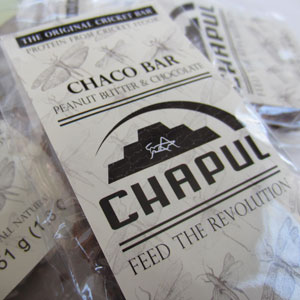Chapul Bars are made from all the typical energy bar ingredients—dates, chocolate, coconut—but with one not-so-standard ingredient: crickets.
The crickets, purchased from Northern Californian cricket farms, are frozen, baked and made into flour, which becomes a crucial ingredient in the bars. There are currently two flavors: the Thai bar, made of coconuts, lime and ginger; and the Chaco bar, comprising peanut butter, dates and dark chocolate.
The fact that the bars have crickets in them is not nearly as exciting, or alarming, as it may sound. There are no visual signs of the insects, and the amount of cricket flour used is so small that the flavor of the other ingredients overpowers their distinct nutty, earthy taste. It’s almost as if they’re not there, which was a deliberate decision on the part of co-founders Pat Crowley, a resident of Salt Lake City, and Dan O’Neill, a California native whose day job is at Intuit in Mountain View.
The strategy behind Chapul bars is actually to ease people into the idea of eating insects. Crowley and O’Neill believe that insects provide a superior source of protein, with less of an environmental impact, than cows, pigs, poultry and fish, the standard sources of protein in the American diet.
“We’re trying to solve a big social and environmental problem. We are starting very small. That’s how revolutions always start,” O’Neill says.
According to O’Neill, the main benefit crickets offer is water conservation. Ten pounds of feed produces 1 pound of cow. That same 10 pounds of feed will produce 8 pounds of cricket. That means less water and resources would be required to produce the same amount of cricket-based protein.
The reason for this difference is that only a small amount of the cow is eaten, whereas all of the cricket can be eaten, not to mention crickets are naturally denser in protein.
As far as O’Neill is concerned, conserving water is a major concern. As the world’s population continues to grow, and more people are able to live middle class lifestyles, the water consumption will skyrocket, causing potentially catastrophic water shortages.
“The math just doesn’t work with the protein options we’re choosing to use right now,” O’Neill says.
Unfortunately, the Chapul revolution faces one big hurdle: whether people in the United States are actually ready and willing to chew on crickets.
“It’s culture-driven,” O’Neill says. “In most countries, insects are part of the diet. I was just in China last week. They have a variety of insects you can buy. In Mexico, they eat chapulines, which are grasshoppers. They put them in tacos. It’s just a normal thing.”
O’Neill compares eating insects to sushi. Forty years ago, no one considered eating raw fish in the United States, but then a couple of sushi bars opened in big cities, mostly for traveling Japanese businessmen, and a few Americans tried it and liked it. Slowly but surely, eating raw fish became a normal part of the diet.
Part of this transition was due to the California roll, which does not actually have any raw fish, but it helped make people become comfortable with eating sushi. O’Neill feels that Chapul bars will serve the same function for insects as the California roll did for raw fish.
“We are introducing people to the concept of eating crickets,” O’Neill explains. “We’re trying to break down that psychological barrier by putting crickets in a familiar product, an energy bar. You’ve tried an energy bar. It has dates and nuts and chocolate. How bad can this be? Over time I think we can expand into different forms and different products.”
Even the decision to use crickets was a calculated one. “The perception of a cricket is somewhat friendlier than the perception of say, a worm. Even if there’s the same protein content in worms, it would be a harder pitch,” O’Neill admits.
The added benefit to using chirpers is that they are already produced on a mass scale for pet food. Chapul is able to choose from lots of different ranches and find people willing to ensure that their crickets meet certain standards.
Chapul bars are available for pre-order on the company’s website at www.chapul.com. They expect to be able to fill orders by the end of August. The public got its first samples this past May at a fair at the Natural History Museum in Los Angeles, and many passersby were pleasantly surprised.
Chapul launched a Kickstarter fundraiser in June to raise $10,000 to open its own kitchen to bake bars on a larger scale. The founders exceeded expectations with a total of $16,065 raised. They hope to get Chapul bars in stores in the near future.

 Color Me Rad 5K Run
Color Me Rad 5K Run  Live Feed: Justin Perez
Live Feed: Justin Perez 


